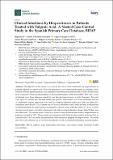Por favor, use este identificador para citar o enlazar a este item:
http://hdl.handle.net/10261/191364COMPARTIR / EXPORTAR:
 SHARE SHARE
 CORE
BASE CORE
BASE
|
|
| Visualizar otros formatos: MARC | Dublin Core | RDF | ORE | MODS | METS | DIDL | DATACITE | |

| Título: | Clinical infections by herpesviruses in patients treated with valproic acid: a nested case-control study in the spanish primary care database, BIFAP |
Autor: | Gil, Miguel; González-González, Rocío; Vázquez-Calvo, Ángela CSIC ORCID; Álvarez-Gutiérrez, Arturo; Martín-Acebes, M. A.; Praena, Beatriz; Bello-Morales, Raquel; Saiz Calahorra, Juan Carlos; López-Guerrero, José Antonio CSIC ORCID; Tabarés, Enrique; Sobrino Castelló, Francisco CSIC ORCID | Palabras clave: | BIFAP Valproic acid Herpesvirus infections Case-control study Electronic health care database |
Fecha de publicación: | 11-sep-2019 | Editor: | Multidisciplinary Digital Publishing Institute | Citación: | Journal of Clinical Medicine 8(9): 1442 (2019) | Resumen: | The objective of this study is to evaluate the risk of clinical infections by herpesviruses in patients exposed to valproic acid (VPA). We performed a case-control study nested in a primary cohort selected from the Spanish primary care population-based research database BIFAP (Base de datos para la Investigación Farmacoepidemiológica en Atención Primaria) over the period 2001–2015. The events of interest were those diseases caused by any herpesviruses known to infect humans. For each case, up to 10 controls per case matched by age, gender, and calendar date were randomly selected. A conditional logistic regression was used to compute adjusted odds ratios (OR) and their 95% confidence intervals (95% CI). Current use of VPA was associated with a trend towards a reduced risk of clinical infections by herpesviruses as compared with non-users (OR 0.84; CI 95% 0.7–1.0; p = 0.057). Among current users, a trend to a decreased risk with treatment durations longer than 90 days was also observed. The results show a trend to a reduced risk of clinical infection by herpesviruses in patients exposed to VPA. These results are consistent with those in vitro studies showing that, in cultured cells, VPA can inhibit the production of the infectious progeny of herpesviruses. This study also shows the efficient use of electronic healthcare records for clinical exploratory research studies. | Versión del editor: | https://doi.org/10.3390/jcm8091442 | URI: | http://hdl.handle.net/10261/191364 | DOI: | 10.3390/jcm8091442 | E-ISSN: | 2077-0383 |
| Aparece en las colecciones: | (CBM) Artículos |
Ficheros en este ítem:
| Fichero | Descripción | Tamaño | Formato | |
|---|---|---|---|---|
| clinical_infections_herpesviruses_patients_treated_valproic_acid.pdf | 544,16 kB | Adobe PDF |  Visualizar/Abrir |
CORE Recommender
PubMed Central
Citations
7
checked on 10-abr-2024
SCOPUSTM
Citations
9
checked on 16-abr-2024
WEB OF SCIENCETM
Citations
8
checked on 23-feb-2024
Page view(s)
213
checked on 19-abr-2024
Download(s)
153
checked on 19-abr-2024

